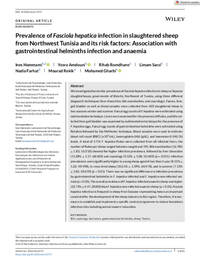Prevalence of Fasciola hepatica infection in slaughtered sheep from Northwest Tunisia and its risk factors: Association with gastrointestinal helminths infection and anaemia

Authors:
We investigated herein the prevalence of Fasciola hepatica infection in sheep at Sejnane slaughterhouse, governorate of Bizerte, Northwest of Tunisia, using three different diagnostic techniques (liver dissection, bile examination, and coprology). Faeces, liver, gall bladder as well as blood samples were collected from 603 slaughtered sheep in two seasons: winter and summer. Faecal egg counts of F. hepatica were estimated using sedimentation technique. Livers were examined for the presence of flukes, and bile collected from gall bladder was examined by sedimentation technique for the presence of F. hepatica eggs. Faecal egg counts of gastrointestinal helminths were estimated using flotation followed by the McMaster technique. Blood samples were used to estimate blood cell count (RBC) (×106/mL), haemoglobin (Hb) (g/dL), and haematocrit (Ht) (%) levels. A total of 1714 F. hepatica flukes were collected from 68 infected livers, the number of flukes per sheep ranged between naught and 195. Bile examination (16.78% ± 1.83; 51/310) showed the higher infection prevalence, followed by liver dissection (11.28% ± 1.17; 68/603) and coprology (9.12% ± 1.08; 55/603) (p = 0.015). Infection prevalences were significantly higher in young sheep aged of less than 1 year (8.13% ± 1.22; 49/498), in cross-bred sheep (10.61% ± 1.39%; 64/478), and in summer (7.13% ± 1.82; 43/293) (p < 0.05). There was no significant difference in infection prevalence by gastrointestinal helminths in F. hepatica-infected and F. hepatica-non-infected animals (p > 0.05). The overall prevalence of F. hepatica-infected anaemic sheep was higher (22.73% ± 4.47; 20/88) than F. hepatica-non-infected anaemic sheep (p < 0.05). Fasciola hepatica infection is frequent in sheep from Sejnane representing hence an important constraint for the development of the sheep industry in this region. Therefore, it is necessary to establish and implement a specific control programme to reduce fasciolosis infection risks including animal owners’ education.
